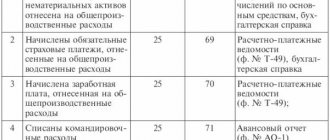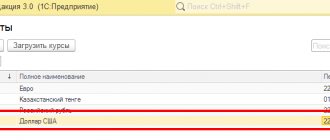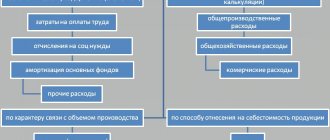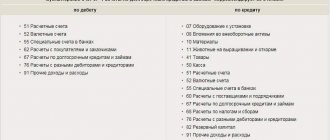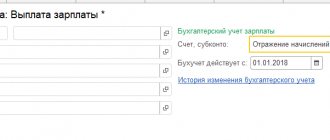Account 91 “Other income and expenses”
November 28, 2014 Accounting for financial results
The financial results of an enterprise’s activities form income and expenses from ordinary activities and other income and expenses.
To account for income and expenses from ordinary activities, account 90 “Sales” is used, which reflects transactions for the sale of goods, finished products, provision of services, performance of work if this is the ordinary activity of the enterprise. The count of 90 was discussed in detail in this article.
To reflect other income and expenses, account 91 is used, which has a similar structure to account 90. This is also a complex account with several sub-accounts, each of which is designed to reflect specific transactions.
Subaccounts of account 91 “Other income and expenses”
The following subaccounts are most often opened:
- 91.1 – intended to reflect other income, the amounts of which are credited to the subaccount;
- 91.2 – intended to reflect other expenses that are entered into the debit of the subaccount;
- 91.9 – formation of financial results (by analogy with the 90th accounts) – the debit of the subaccount records the profit received from other income and expenses, and the credit records the loss.
Other income and expenses reflected on account 91 include non-operating and operating income and expenses. By the way, extraordinary expenses are not included among others, but are reflected directly in account 99 “Profits and losses”.
What income can be reflected on the credit of subaccount 91.1:
- Rent payments from tenants;
- Dividends,% on securities, on loans issued;
- Proceeds from the sale of fixed assets, intangible assets, materials, if this is not the usual activity of the organization;
- Fines, penalties, penalties received when the counterparty violates the terms of contracts and other agreements;
- Income from assets received free of charge;
- Compensation for damage caused to the organization;
- Profit from previous years;
- Expired accounts payable;
- Exchange differences, etc.
Postings on account credit 91 subaccount 1
D62 (76) K91.1 – reflects the cost of accrued rental payments receivable.
D62 (76) K91.1 – dividends and interest on securities accrued.
D62 K91.1 – proceeds from the sale of assets.
D66 (67) K91.1 - % receivable on issued credits and loans.
D98 K91.1 – income from property received free of charge.
D62 K91.1 – profit of previous years is reflected.
D62 K91.1 – accounts payable with an expired statute of limitations are written off.
D57 (52) K91.1 – positive exchange rate difference from the purchase of foreign currency.
D62 K91.1 – the amount of the reserve for doubtful debts is included in other income.
D99 K91.1 – loss from other activities of the organization is reflected.
What expenses can be reflected in the debit of subaccount 91.2:
- Costs of transferring property for rent;
- Cost of assets being sold: for fixed assets and intangible assets - residual value, for tangible and other assets - actual cost;
- Expenses associated with the sale of fixed assets, intangible assets, material assets, if these sales are not the usual activity of the organization;
- % on loans taken;
- Bank commissions and other fees for services of credit institutions;
- Paid fines, penalties, penalties;
- Expenses for conservation facilities;
- Compensation for damage caused by the organization;
- Losses from previous years;
- Expired accounts receivable;
- Exchange differences, etc.
Postings to the debit of account 91 subaccount 2
D91.2 K01 – the residual value of a fixed asset intended for sale is written off.
D91.2 K04 – the residual value of intangible assets intended for sale is written off.
D91.2 K10 – the cost of materials sold is written off.
D91.2 K66 (67) – interest accrued for payment on loans and borrowings taken out.
D91.2 K20 – costs for conservation of objects.
D91.2 K60 – expired accounts receivable are included in other expenses.
D91.2 K99 – profit from other activities is reflected.
Closing account 91 at the end of the year
During the month, other expenses and income are accumulated in the debit of subaccount 91.2 and the credit of subaccount 91.1. At the end of the month, the difference between the debit and credit of account 91 is calculated, the final balance is displayed, which is reflected in subaccount 91.9 in correspondence with account 99. The total profit for the month is recorded for debit 91.9, and the loss for credit.
Thus, at the end of the month the synthetic account, as a whole, has a zero balance. But on each individual sub-account the balance remains and accumulates from month to month.
At the end of the year, account 91 is closed.
All subaccounts (except 91.9) are closed to subaccount 91.9 so that the final balance for each subaccount becomes zero.
Postings for closing account 99:
D91.1 K91.9 – closing subaccount 91.1, posting is performed for the amount of the final credit balance of subaccount 91.1.
D91.9 K91.2 – closing subaccount 91.2, posting is carried out for the amount of the final debit balance of subaccount 91.2.
Thus, at the end of the year, the balance for each subaccount and for account 91 as a whole is equal to 0. At the beginning of the next year, account 91 is opened anew.
Source: https://buhs0.ru/schet-91-prochie-doxody-i-rasxody/
Correspondence of possible accounts
| Debit | Credit |
| 01, 04, 07, 02, 08, 03 NMA and OS | 91 “Other income and expenses” |
| 19, 16, 15, 14, 11, 10 Current assets, VAT | |
| 21, 20, 28, 29, 23 Defects, costs by department | |
| 58, 59 reserves, investments | |
| 66, 68, 69, 67, 60, 63 Settlements, loans | |
| 70, 76, 73, 79, 71 Settlements with personnel and other creditors and debtors | |
| 98, 99, 94 financial result, funds, losses and shortages of goods and materials |
Account 91 in accounting: Other income and expenses
Accounting account 91 is an active-passive account “Other income and expenses”, used to obtain information about the expenses and income of the enterprise for activities that are not the main one. Using standard postings and practical examples, we will consider the specifics of using account 91 and the features of accounting for other income and expenses.
Closing 91 accounts
All subaccounts under the “Other income and expenses” account at the end of the year: balance for December, internal records - must be closed by posting to subaccount 91.09.
The financial result is credited to the debit (loss) or credit (profit) of account 99 “Profits and losses”.
Here is a schematic example of closing 91 accounts:
Postings to 91 accounts “Other income and expenses”
Correspondence and main transactions for 91 accounts are shown in the table:
| Dt | CT | Wiring Description | A document base |
| 91 | 01 | Write-off of retired fixed assets at residual/initial value. | OS-1, SP-51 |
| 91 | 02 | Calculation of depreciation on fixed assets that are leased (not an object of activity). | Accounting statement, Depreciation sheet |
| 91 | 03/04 | Write-off of retired income-generating investments in tangible assets (hereinafter referred to as MT)/intangible assets. | Accounting certificate, Acceptance certificate |
| 91 | 07 | Write-off of equipment for installation (sold/transferred free of charge) at cost. | Acceptance certificate, Invoice |
| 91 | 08 | Write-off of the cost of investments in VNA. | Certificate of acceptance and transfer, Certificate of gratuitous transfer of valuables |
| 91 | 10 | Write-off of materials sold/transferred free of charge (upon disposal of fixed assets) at actual cost. | Acceptance certificate, Invoice |
| 91 | 11 | Write-off of the cost of sold animals (not an activity item). | TTN (SP-32) |
| 91 | 14/59/63 | Creation of a reserve to reduce the value of the capital asset/ensure investments in securities/for doubtful debts. Write-off of amounts to reserves – by reverse posting. | Accounting certificate, accounting calculation for creating a reserve |
| 91 | 15 | Reflection of write-off of materials (actual cost). | Acceptance certificate, Invoice |
| 91 | 16 | Write-off of the share of deviations from the accounting cost of materials sold (if a negative value - a red reversal). | Accounting certificate, accounting calculation for writing off deviations |
| 91 | 19 | Write-off of VAT on materials sold (non-refundable). | Accounting information |
| 91 | 20/21/23 Get 267 video lessons on 1C for free:/29 | Write-off of expenses for maintaining production facilities/facilities for conservation. | Accounting certificate, accounting calculations |
| 91 | 23 | Write-off of the cost of services of auxiliary production (upon disposal of fixed assets). | |
| 91 | 28 | Write-off of the cost of irreparable defects (work of an operational nature). | |
| 91 | 43 | Write-off of commercial expenses (for the sale of operating systems, materials). | |
| 91/19 | 60 | Reflection of amounts accrued by the contractor for work/services performed upon liquidation/sale of fixed assets, other assets/VAT amount. | Invoice |
| 91 | 60/62/76 | The amount of receivables/debt is written off after the expiration of the statute of limitations/ cannot be recovered in any way. | INV-17, Accounting certificate, Minutes/order of the manager |
| 91 | 66/67 | Reflection of the percentage amount payable for using credits/loans. | Accounting certificate, Bank account statement |
| 91 | 68 | VAT accrual (income from the sale of operating systems/materials). | Accounting certificate, VAT accounting calculation |
| 91 | 70/69/10 | Reflection of expenses for liquidation of OS-v. | Work order for piece work, Certificate of write-off of valuables |
| 91 | 75 | Reflection of expenses (simple partnership agreement). | Accounting certificate-calculation |
| 91 | 51/76 | Reflection of violations of the terms of business contracts (paid/recognized for payment). | Bank account statement, Invoice, Accounting certificate |
| 91.02 91.01 | 52/60/62/58/…+ 55/67 | Reflection of exchange rate differences (negative). Positive - reverse wiring. | Act on revaluation of values, Accounting certificate |
| 91 | 73 | Write-off of the cost of material damage (it is unrealistic to recover, for example, a court refusal). | INV-17, Manager's order, Accounting certificate |
| 91 | 76 | Payment for services of credit institutions/expenses for consideration of cases in the courts. Profit receivable under a simple partnership agreement/% on loans, income on shares, shares and securities/fines, penalties and interest for violation of the terms of agreements – reverse posting. | Accounting certificate, Notice/Bank statement, Invoice, KO-1 |
| 91 | 79 | Reflection of expenses on transactions with structural divisions (on a separate balance sheet). Reflection of income - reverse posting. | Invoice, Advice |
| 91 | 81 | The difference between actual costs (repurchase of shares/shares) and the nominal value (participant’s own shares/shares). When repurchasing, the difference is reflected by reverse posting. | Accounting statement, calculation of the difference between the actual costs of repurchasing shares and their nominal value |
| 91 | 94 | Write-off of the cost of shortage of valuables in excess of the norm / from damage (in the absence of specific culprits). | INV-3, Manager's order, Accounting certificate |
| 91 | 98 | Write-off of other income amounts (future periods). Enrollment – reverse posting. | Accounting information |
| 99.02/99.03 | 91 | Write-off of the balance of income/expenses at the end of the month. | Calculation of the balance of other income and expenses, Accounting certificate |
| 96 | 91 | Crediting to income the amount of unused reserve for upcoming expenses/payments. | Accounting information |
| 60/76 | 91 | Crediting of accounts payable/receivable (unclaimed after the expiration of the limitation period). | INV-17 |
| 10/62 | 91 | The amounts of transactions with containers are reflected. | Waybill, Invoice |
| 07/10/11/41/43/4508/20/21/29/23 | 91 | The surplus/unaccounted amounts of inventory items identified during the inventory are reflected. | INV-3, INV-19, INV-24 |
Example 1. Accounting for other rental income on account 91.01
Let's say Leto LLC, with its main activity in the production of confectionery products, receives income from renting out premises in one of the industrial buildings. The tenant of “Vasilek” pays 50,000 rubles monthly, according to the concluded agreement. Payment for rent was credited to the account in the amount of 50,000 rubles.
The amount of monthly expenses incurred by Leto LLC for maintaining the premises consists of:
- depreciation charges - 2,000 rubles;
- wages for service personnel - 8,000 rubles;
- wage taxes - 1,500 rubles;
- utilities and other services - 3,000 rubles.
Based on the results of November 2021, the following entries were made in the accounting department of Leto LLC:
| Dt | CT | Wiring Description | Amount, rub. | A document base |
| 76 | 91.01 | The amount of rent for November 2021 has been accrued | 50 000 | Certificate of completion |
| 91.02 | 02/70/69/23 | The costs of maintaining the rented premises were written off (2,000 + 8,000 + 1,500 + 3,000) | 14 500 | Receipts, invoices, acts, etc. |
| 51 | 76 | Payment for rental services has been credited to the personal account received from the tenant “Vasilek” | 50 000 | Bank statement |
Example 2. Accounting for other income from the sale of materials on account 91.01
Let’s assume that Leto LLC sold other materials not used in the production of confectionery products. Wherein:
- sales cost - 40,000 rubles;
- cost of materials - 15,000 rubles;
- salary and taxes on wages of production workers - 4,000 rubles.
Accounting for other income from materials sold was reflected in the accounting of Leto LLC with the following entries to account 91:
| Dt | CT | Wiring Description | Amount, rub. | A document base |
| 76 | 91.01 | Accrued income from the sale of materials | 40 000 | Sales Invoice |
| 91.02 | 10 | The cost of materials has been written off | 15 000 | Costing |
| 91.02 | 23 | Costs associated with sales (salaries and taxes) are written off | 4 000 | Payroll |
| 51 | 76 | Funds received for materials sold | 40 000 | Bank statement |
Example 3. Accounting for banking services on account 91.02
Let’s say Leto LLC has entered into an agreement with a bank for the provision of services. At the end of the month (reporting period), the bank provided the following services:
- for installing the Bank-Client system for a period of 3 years (one-time service) - 7,000 rubles;
- for “Bank-Client” service (monthly service) - 400 rubles;
- for settlement and cash services (RKO) - 2,000 rubles;
- for cash collection - 6,000 rubles.
In the accounting of Leto LLC, entries were made to reflect banking services:
| Dt | CT | Wiring Description | Amount, rub. | A document base |
| 91.02 | 60 | RKO services are reflected | 2 000 | Agreement for servicing a bank account, bank statements |
| 91.02 | 60 | Cash collection expenses | 6 000 | Certificate of services rendered |
| 91.02 | 60 | Costs for installing “Bank-Client” | 7 000 | Certificate of services rendered |
| 91.02 | 60 | Expenses for servicing “Bank-Client” per month | 400 | Certificate of services rendered |
Source: https://BuhSpravka46.ru/buhgalterskiy-plan-schetov/schet-91-v-buhgalterskom-uchete-prochie-dohodyi-i-rashodyi.html
91 accounts – active or passive
Accounting account 91 is an active-passive collective account for other transactions related to the company’s additional activities. The information displayed for the accounting period on this account includes both income and expenses.
Account 91 “Other income and expenses” in the loan summarizes data on:
- Proceeds from rental obligations or from the provision for a fee of rights to patents, industrial designs - as a rule, correspondence of account 91 is carried out with cash or current accounts.
- Income from the company’s participation in the work of other companies, from interest obligations, and simple partnership agreements.
- Income from the sale of enterprise assets.
- Penalties for non-compliance with contractual terms.
- Compensation for losses caused to the company.
- Income from gratuitous receipt of assets.
- Amounts of arising exchange rate differences, losses of previous periods.
- Amounts of a creditor whose claims have expired.
- Other income.
Account 91 “Other income and expenses” in debit summarizes data on:
- Expenses on lease obligations in connection with participation in the charter of other companies.
- Amounts of write-off of the residual value of assets upon their disposal.
- The organization's expenses for operations with containers.
- Paid interest obligations.
- Bank commissions.
- Paid penalties for violation of contracts.
- Payable for losses caused by the company.
- Losses recognized in the current period for previous years.
- Amounts of receivables with an expired limitation period.
- Amounts of resulting exchange rate differences.
- Costs of considering cases in courts.
- Other expenses.
From the list above, it becomes clear that 91 accounts in the accounting department increase by credit and decrease by debit.
The ending balance is closed at the end of the reporting period using special entries.
Subaccounts 91 accounts:
- 91.1 “Other income” - 91 1 accounting account is intended to reflect various income transactions for non-core activities of the company. An exception is extraordinary income of the organization.
- 91.2 “Other expenses” - account 91 2 in accounting is used to reflect transactions on expenses not related to the main activities of the business.
- 91.
9 “Balance of other income/expenses - the account is intended for monthly calculation of the balance of 91 accounts. in order to close it. At the same time, the balance of the remaining sub-accounts continues to “hang”, which allows you to obtain information about the accumulated balances at any time. Closing with final transactions is written off to the debit or credit of the savings account. 99.
The financial characteristics of account 91 “Other income and expenses” make it possible to obtain generalized information on those operations of the company that are not directly related to the main types of OKVED. As a rule, such operations do not greatly affect the financial results of a business, but are nevertheless important for calculating reliable data on income, costs, and profits.
Information can be presented in a generalized form or with analytics by types of income and expenses.
Typical transactions for account 91:
- D account 91 02 K 66, 67 – the accrual of credit percentage is reflected.
- D 91.02 K 10 – reflects the write-off of inventory items upon disposal.
- D 91.09 K 99 – the closing of the account balance is reflected.
- D 91.02 K 70 – reflects the accrual of semi-annual bonuses to staff.
- D 10 (41, 01) K 91.01
- surplus inventory, goods, fixed assets were identified. - D 76 K 91.01 – reflects the accrual of interest on bonds.
- D 91.02 K 76 – reflects the accrual of the commission for the bank’s cash settlement services.
- D 51 K 91.01 – reflects the receipt of penalties for non-compliance with contractual terms.
Account correspondence
| Debit | Credit |
| 91 “Other income and expenses” | 08, 07 Non-current assets |
| 10, 11, 15, 14 Current assets | |
| 20, 29, 23, 28 cost accounts, production defects | |
| 41, 43, 45 Finished, shipped products | |
| 50, 52, 59, 57, 51, 58, 55 cash | |
| 60, 63, 66, 62, 67 settlements with counterparties, loans | |
| 71, 76, 79, 73 various debtors and creditors, accountable persons | |
| 96, 99, 98 financial results, reserves, funds |
